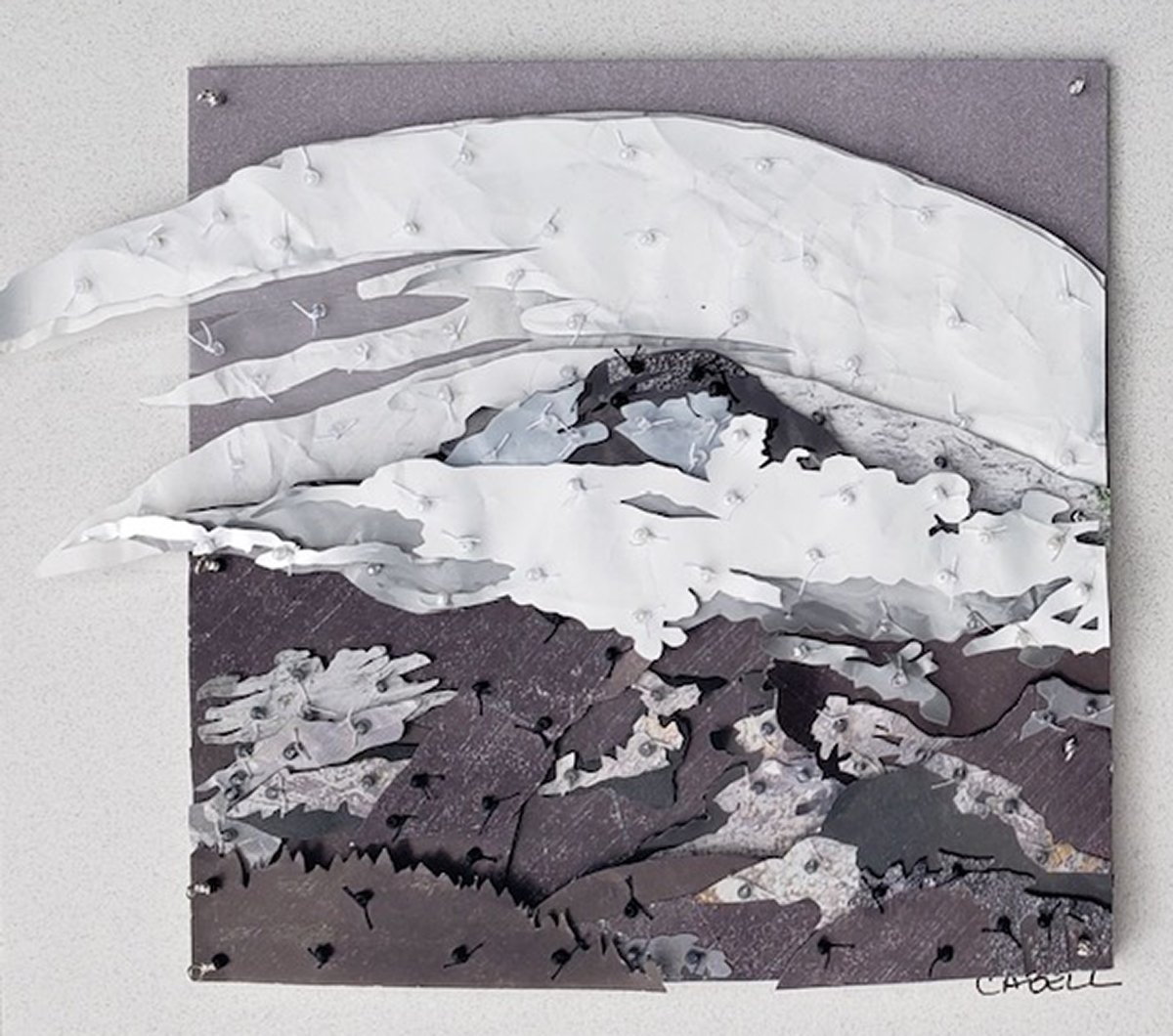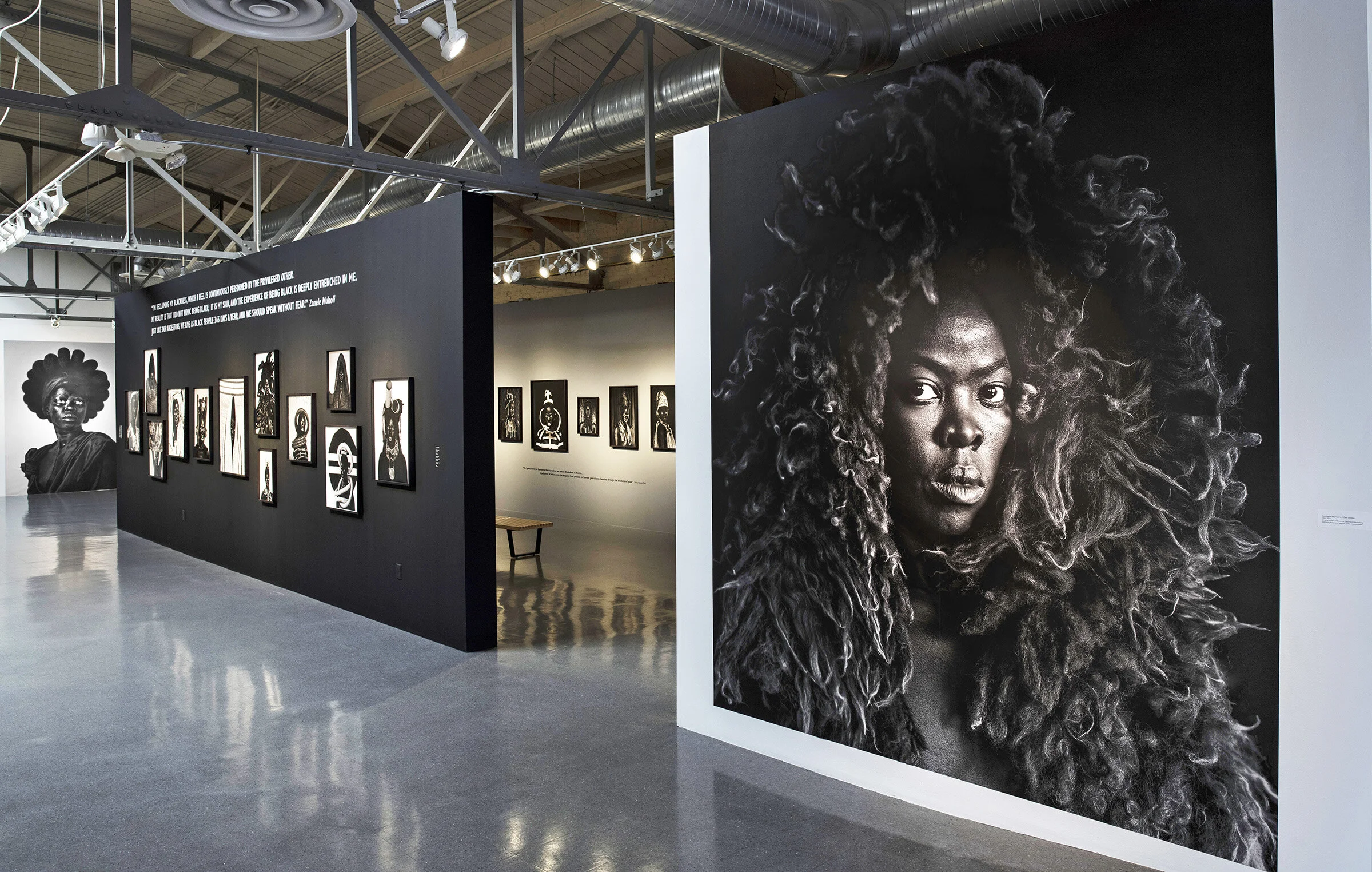Light Contrasting with Dark
Terrel Bailey and Leigh Cabell: Light Contrasting with Dark
Artists on Santa Fe Gallery
747 Santa Fe Drive, Denver, CO 80204
October 2-29, 2023
Admission: Free
Review by Danielle Cunningham
When self-proclaimed trash sculptor Leigh Cabell met photographer Terrel Bailey at the former’s exhibition, she immediately hoped for a future collaboration. [1] Cabell has always worked with re-purposed materials in a subversion of human consumption and waste, while Bailey focuses on conservation education through photography. Though the artists work in markedly divergent mediums, these shared interests became connective points. With Light Contrasting with Dark, their second collaborative exhibition at the Artists on Santa Fe Gallery, Bailey and Cabell have honed their artistic relationship, generating unexpectedly cohesive works that are as natural as their subject matter.
A view of the exhibition Light Contrasting with Dark by Terrel Bailey and Leigh Cabell at Artists on Santa Fe Gallery. Image by DARIA.
Bailey’s mostly black-and-white images establish nature as sublime, with many wide-angle landscapes centering vast spaces, immaculate mountain tops, and seemingly endless horizon lines. As a recovering alcoholic, Bailey embraces the isolation and humility he has experienced in the natural world. His artistic mission is personal as well as community minded. He seeks to educate the public about the dire need for conservation. [2]
Terrel Bailey, Humbled, 2022, archival pigment print, 18 x 24 inches. Image courtesy of the artist.
Leigh Cabell, Humbled, 2023, coffee bags, chip bags, calendar, envelopes, mailer, thread, and seed beads, 8 x 8 inches. Image courtesy of the artist.
Cabell shares this urgency around conservation and works directly with materials that aid in environmental protection. To create her small, semi-sculptural works, Cabell delicately assembles pieces of trash—mostly single-use plastics like chip bags and coffee bags. The artist and former marine biologist doesn’t use adhesives or manipulate the colors of her source material, but allows her materials to dictate color and form. For this exhibition, she responded to Bailey’s photographs, sewing together bits of trash that range in color from true blacks to dusty greys and metallics. [3]
Terrel Bailey, Pink Clouds, 2019, archival pigment print, 17 x 29 inches. Image courtesy of the artist.
Only two works vary from the black and white theme, calling attention to nature's sometimes hyper-vibrant hues. The most striking of the two is Pink Clouds, in which Bailey captures a scene well known in Colorado. Pink- and orange-tinged clouds drift lazily over purple mountains while thin avenues of snow cascade down the mountain slope.
Leigh Cabell, Pink Clouds, 2023, chip bag, shopping bags, mailers, envelopes, thread, and seed beads, 8 x 8 inches. Image by DARIA.
Cabell responds to this scene with tiny details, using wrinkled paper to stand in for the sky and effectively minimizing Bailey’s grandiosity in an intimate composition. Rendered in plastic, the great outdoors becomes as easily dismissed as Cabell’s trash, which is exactly the message the artists suggest is conveyed today as humanity moves further away from nature and closer to disposable commodities.
Terrel Bailey, The Road to Somewhere?, 2018, archival pigment print, 20 x 16 inches. Image courtesy of the artist.
Road to Somewhere? is another anomaly in the exhibit since it is the only work to depict human intervention in nature. In Bailey’s image, a two-lane highway plunges from the foreground to the center of the photograph, cutting through a valley beneath a wide umbrella of cumulous clouds. The artist’s perspective emphasizes the blackness of the road, which blankets the bottom half of the composition and calls up psychological feelings of domination and darkness in spite of the bright and expansive sky. Countering this ominous tone, a mountain range contains the road, preventing it from venturing too far into the wild.
Leigh Cabell, The Road to Somewhere?, 2023, calendars, chip bags, cereal liner, envelopes, craft paper, thread, and seed beads, 8 x 9 inches. Image by DARIA.
Cabell’s road is much smaller and less daunting, allowing the clouds and sloping mountains to take visual precedence. The clouds can’t be contained and even sweep off the picture plane—spilling into reality. Unlike the duo’s other pairings, in which Bailey’s photographs are larger and realistic, Cabell’s imagined natural world dominates in this selection. Its tiny elements overshadow Bailey’s dark largess by subtly reversing Bailey’s visual hierarchy. Perhaps this is wishful thinking by Cabell as she creates an imaginary world where the human-made never overshadows nature.
Terrel Bailey, Disappearing Glaciers, 2021, archival pigment print, 18 x 24 inches. Image courtesy of the artist.
Leigh Cabell, Disappearing Glaciers, 2023, chip bags, magazines, calendar, envelopes, mailer, thread, and seed beads, 8 x 9 inches. Image courtesy of the artist.
Because the artists are interested in conservation, their work Disappearing Glaciers summarizes the exhibition’s concept as much as it does their respective aesthetics. A distant, hulking mountain dominates the frame in Bailey’s photograph and wispy but opaque clouds arch over the mountaintop, which contains inconsistent clusters of snow on all sides. Another mountainside is visible in the foreground, densely covered in pine trees. As the title implies, the mountain is presumably a glacier, receding slowly across a glacial valley as its surface thaws. In Cabell’s work, the clouds are the focus, spatially consuming the glacier and its accompanying tree-lined mountain.
Terrel Bailey, Not as Cold as it Seems, 2023, archival pigment print, 17 x 29 inches. Image courtesy of the artist.
Despite their material differences, Cabell and Bailey work in tandem to encourage reverence for nature and underscore the importance of conservation. Bailey connects viewers to nature’s emotional potential, while Cabell proposes the logical necessity of limiting the production and use of plastic goods.
Leigh Cabell, Not as Cold as it Seems, 2023, chip bags, nut bags, magazines, cereal liner, craft paper, thread, and seed beads, 8 x 8 inches. Image courtesy of the artist.
Though this collaboration is visually and materially disparate, each artist contributes a unique perspective that achieves a harmonious end result. By highlighting the personal and collective experiences nature provides, as well as the immediate need for education, Cabell and Bailey suggest that artists have a responsibility to reveal subjects that aren’t directly related to art.
Danielle Cunningham (she/her) is an artist, scholar, and independent curator. She writes about science fiction, gender, sexuality, and disability, with an emphasis on mental illness. The co-founder of chant cooperative, an artist co-op, she holds a master’s degree in Art History and Museum Studies from the University of Denver.
[1] From my conversation with Cabell.
[2] From the Bailey’s website: https://www.liftedspiritphotos.com/about-lifted-spirit-photos.
[3] From the Cabell’s website, https://www.leighcabell.com/about, and my conversation with the artist.


















